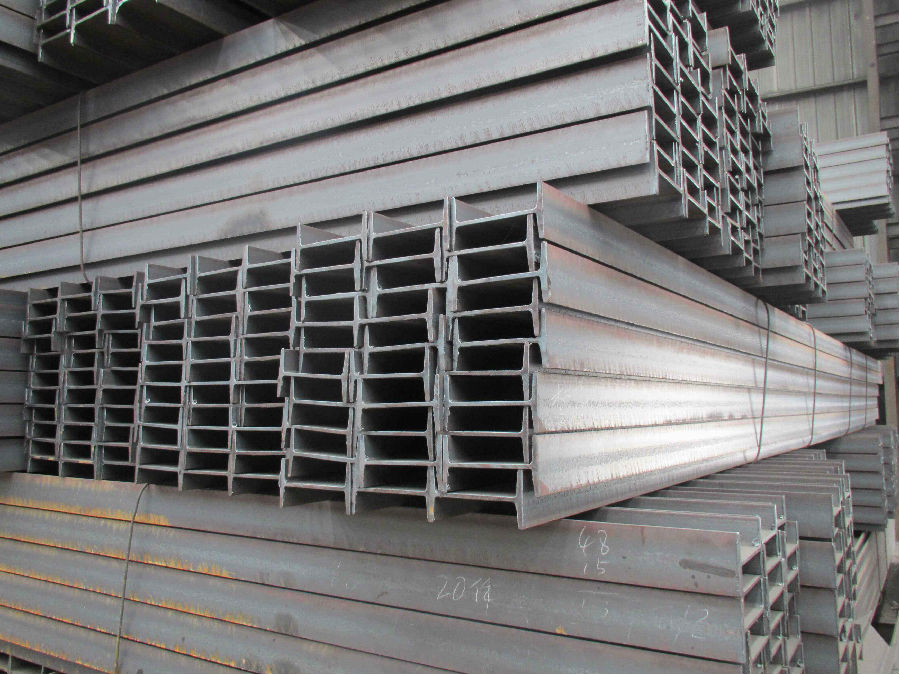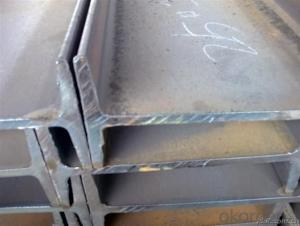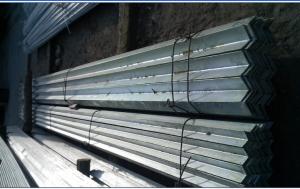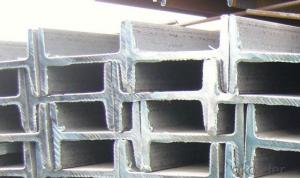Hot Rolled Q235 Steel Structural I-Beam
- Loading Port:
- China main port
- Payment Terms:
- TT or LC
- Min Order Qty:
- 2000 PCS
- Supply Capability:
- 40000 PCS/month
OKorder Service Pledge
OKorder Financial Service
You Might Also Like
OKorder is offering high quality Hot Rolled Q235 Steel Structural I-Beams at great prices with worldwide shipping. Our supplier is a world-class manufacturer of steel, with our products utilized the world over. OKorder annually supplies products to European, North American and Asian markets. We provide quotations within 24 hours of receiving an inquiry and guarantee competitive prices.
Product Applications:
Hot Rolled Q235 Steel Structural I-Beams are ideal for structural applications and are widely used in the construction of buildings and bridges, and the manufacturing, petrochemical, and transportation industries.
Product Advantages:
OKorder's Steel I-Beams are durable, strong, and resist corrosion.
Main Product Features:
· Premium quality
· Prompt delivery & seaworthy packing (30 days after receiving deposit)
· Corrosion resistance
· Can be recycled and reused
· Mill test certification
· Professional Service
· Competitive pricing
Product Specifications:
Brand: Baoming
Grade: SS400 – SS490
Model Number: GTLM-price-1201
Dimensions:
Leg Height: 95 – 2235.10mm
Depth: 55 – 119.5mm
Place of Origin: Guizhou, China
Color: As per customer request
FAQ:
Q1: Why buy Materials & Equipment from OKorder.com?
A1: All products offered byOKorder.com are carefully selected from China's most reliable manufacturing enterprises. Through its ISO certifications, OKorder.com adheres to the highest standards and a commitment to supply chain safety and customer satisfaction.
Q2: How do we guarantee the quality of our products?
A2: We have established an advanced quality management system which conducts strict quality tests at every step, from raw materials to the final product. At the same time, we provide extensive follow-up service assurances as required.
Q3: How soon can we receive the product after purchase?
A3: Within three days of placing an order, we will begin production. The specific shipping date is dependent upon international and government factors, but is typically 7 to 10 workdays.
Q4: What makes stainless steel stainless?
A4: Stainless steel must contain at least 10.5 % chromium. It is this element that reacts with the oxygen in the air to form a complex chrome-oxide surface layer that is invisible but strong enough to prevent further oxygen from "staining" (rusting) the surface. Higher levels of chromium and the addition of other alloying elements such as nickel and molybdenum enhance this surface layer and improve the corrosion resistance of the stainless material.
Q5: Can stainless steel rust?
A5: Stainless does not "rust" as you think of regular steel rusting with a red oxide on the surface that flakes off. If you see red rust it is probably due to some iron particles that have contaminated the surface of the stainless steel and it is these iron particles that are rusting. Look at the source of the rusting and see if you can remove it from the surface.
Images:


- Q:What are the different methods of transporting steel I-beams to construction sites?
- Different methods can be used to transport steel I-beams to construction sites, depending on factors like beam size, weight, and site accessibility. Here are some commonly employed approaches: 1. Flatbed trucks: Steel I-beams are most frequently transported using flatbed trucks. These trucks have a spacious flat platform that facilitates easy loading and unloading of the beams. They are versatile and can transport a wide range of beam sizes and weights. 2. Crane trucks: For larger and heavier I-beams, crane trucks are typically utilized. These trucks feature a hydraulic crane mounted on the back, enabling them to lift and move beams onto the construction site. Crane trucks are particularly useful when site access is limited or when precise beam placement is required. 3. Rail transportation: In cases where the distance between the steel mill and the construction site is considerable, rail transportation may be employed. Specialized railcars, such as flatcars or gondolas, designed for carrying large and heavy loads, are used to transport the steel I-beams. This method is efficient for long-distance transportation, especially when dealing with large quantities of beams. 4. Barge transportation: When construction sites are situated near bodies of water, like rivers or coastal areas, barge transportation is a viable option. Barges are flat-bottomed boats capable of carrying heavy loads. Steel I-beams can be loaded onto barges and transported to the construction site by water, offering an efficient and cost-effective solution for large-scale projects. 5. Air transportation: In exceptional circumstances where time is critical or construction site access is extremely challenging, air transportation may be considered. Helicopters or cargo planes can be employed to lift and transport steel I-beams directly to the construction site. However, due to the high costs involved, this method is typically reserved for urgent or remote projects. When determining the most suitable method of transportation for steel I-beams, it is crucial to consider factors like beam size, weight, and site accessibility. Each method has its advantages and limitations, and the choice will depend on the specific requirements and constraints of the project.
- Q:Can steel I-beams be used in retail or commercial renovation projects?
- Yes, steel I-beams can be used in retail or commercial renovation projects. Steel I-beams are commonly used in construction due to their strength and load-bearing capabilities. They provide structural support and can be used to reinforce existing structures or create new openings in walls. Their versatility and durability make them suitable for various renovation projects in the retail or commercial sector.
- Q:Can Steel I-Beams be used for data centers?
- Yes, steel I-beams can be used for data centers. They are commonly used in the construction of data centers due to their strength, durability, and ability to support heavy loads. Additionally, steel I-beams can provide stability and structural integrity to ensure the safety of critical equipment and infrastructure within a data center.
- Q:Are steel I-beams suitable for supporting large spans?
- Yes, steel I-beams are suitable for supporting large spans. Steel I-beams are commonly used in construction because of their high strength-to-weight ratio, which allows them to support heavy loads over long distances. They are capable of spanning large distances without the need for additional support columns or beams. Additionally, steel I-beams have excellent resistance to bending and deflection, making them ideal for supporting large spans with minimal sagging or deformation. Overall, steel I-beams are a reliable and efficient choice for supporting large spans in various applications, including bridges, high-rise buildings, and industrial structures.
- Q:What are the standard sizes and dimensions of steel I-beams?
- The standard sizes and dimensions of steel I-beams vary depending on the specific requirements and industry standards. However, some common standard sizes include 3", 4", 6", 8", 10", 12", 14", 16", 18", 20", 22", 24", and larger. These dimensions refer to the height of the beam, while the width can range from 1.375" to 12.25" or more. The weight per foot and length of the beam also vary based on the size and type of I-beam.
- Q:What span is the maximum span for I-beam?
- 1. determine the steel beam span, load point position and weight, make the bending moment diagram, and calculate the maximum bending moment M (MAX)2. general I-beam material is Q235, sigma (s) =2400KG/CM2, determine safety factor, generally take 1.7, [Sigma]=2400/1.7=1412KG/CM23.M (MAX) /]<=W (x), to meet the strength. W (x) refer to the mechanical design handbook for the bending modulus of i-beam.
- Q:Are there any limitations to the use of steel I-beams in construction?
- Yes, there are limitations to the use of steel I-beams in construction. One limitation is their weight, which makes them difficult to maneuver and install in certain locations. Additionally, steel I-beams have a limited span length, meaning they may require additional support or columns for longer distances. Moreover, steel I-beams are susceptible to corrosion if not properly protected, and their cost can be higher compared to alternative materials in some cases. Nevertheless, these limitations can be mitigated through proper design, planning, and maintenance.
- Q:What is the most cost-effective size for a steel I-beam?
- The most cost-effective size for a steel I-beam depends on various factors such as the load it needs to support, the span or distance it needs to cover, and the specific requirements of the project. A structural engineer or a steel fabricator would be best suited to determine the most cost-effective size based on these specific project parameters.
- Q:The steel I-beam and which is better
- Sure I go! But if groove steel can solve your problem, there is no need to spend it
- Q:Can steel I-beams be used for skylights or atriums?
- No, steel I-beams are not typically used for skylights or atriums. Skylights and atriums require materials that are transparent or translucent in order to allow natural light to pass through. Steel I-beams, on the other hand, are solid and opaque, making them unsuitable for these applications. Skylights and atriums are usually constructed using materials such as glass, acrylic, or polycarbonate, which are able to transmit light while maintaining structural integrity. These materials are specifically designed to maximize the amount of natural light entering a space while providing the necessary strength and durability.
1. Manufacturer Overview |
|
|---|---|
| Location | |
| Year Established | |
| Annual Output Value | |
| Main Markets | |
| Company Certifications | |
2. Manufacturer Certificates |
|
|---|---|
| a) Certification Name | |
| Range | |
| Reference | |
| Validity Period | |
3. Manufacturer Capability |
|
|---|---|
| a)Trade Capacity | |
| Nearest Port | |
| Export Percentage | |
| No.of Employees in Trade Department | |
| Language Spoken: | |
| b)Factory Information | |
| Factory Size: | |
| No. of Production Lines | |
| Contract Manufacturing | |
| Product Price Range | |
Send your message to us
Hot Rolled Q235 Steel Structural I-Beam
- Loading Port:
- China main port
- Payment Terms:
- TT or LC
- Min Order Qty:
- 2000 PCS
- Supply Capability:
- 40000 PCS/month
OKorder Service Pledge
OKorder Financial Service
Similar products
New products
Hot products
Hot Searches
Related keywords





























